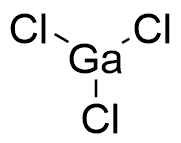Gallium(III) chloride anhydrous is widely utilized in research focused on:
- Chemical Synthesis: It serves as a catalyst in various organic reactions, enhancing reaction rates and yields, particularly in the synthesis of pharmaceuticals and fine chemicals.
- Semiconductor Manufacturing: This compound is crucial in the production of gallium-based semiconductors, which are essential for high-efficiency solar cells and LED technology.
- Analytical Chemistry: It is used in analytical techniques such as spectroscopy and chromatography, aiding in the detection and quantification of trace elements in samples.
- Material Science: Gallium(III) chloride is employed in the fabrication of advanced materials, including thin films and nanostructures, which have applications in electronics and optoelectronics.
- Pharmaceutical Applications: It has potential uses in drug formulation and delivery systems, leveraging its unique properties to improve bioavailability and therapeutic effectiveness.
General Information
Properties
Safety and Regulations
Applications
Gallium(III) chloride anhydrous is widely utilized in research focused on:
- Chemical Synthesis: It serves as a catalyst in various organic reactions, enhancing reaction rates and yields, particularly in the synthesis of pharmaceuticals and fine chemicals.
- Semiconductor Manufacturing: This compound is crucial in the production of gallium-based semiconductors, which are essential for high-efficiency solar cells and LED technology.
- Analytical Chemistry: It is used in analytical techniques such as spectroscopy and chromatography, aiding in the detection and quantification of trace elements in samples.
- Material Science: Gallium(III) chloride is employed in the fabrication of advanced materials, including thin films and nanostructures, which have applications in electronics and optoelectronics.
- Pharmaceutical Applications: It has potential uses in drug formulation and delivery systems, leveraging its unique properties to improve bioavailability and therapeutic effectiveness.
Documents
Safety Data Sheets (SDS)
The SDS provides comprehensive safety information on handling, storage, and disposal of the product.
Product Specification (PS)
The PS provides a comprehensive breakdown of the product’s properties, including chemical composition, physical state, purity, and storage requirements. It also details acceptable quality ranges and the product's intended applications.
Certificates of Analysis (COA)
Search for Certificates of Analysis (COA) by entering the products Lot Number. Lot and Batch Numbers can be found on a product’s label following the words ‘Lot’ or ‘Batch’.
*Catalog Number
*Lot Number
Certificates Of Origin (COO)
This COO confirms the country where the product was manufactured, and also details the materials and components used in it and whether it is derived from natural, synthetic, or other specific sources. This certificate may be required for customs, trade, and regulatory compliance.
*Catalog Number
*Lot Number
Safety Data Sheets (SDS)
The SDS provides comprehensive safety information on handling, storage, and disposal of the product.
DownloadProduct Specification (PS)
The PS provides a comprehensive breakdown of the product’s properties, including chemical composition, physical state, purity, and storage requirements. It also details acceptable quality ranges and the product's intended applications.
DownloadCertificates of Analysis (COA)
Search for Certificates of Analysis (COA) by entering the products Lot Number. Lot and Batch Numbers can be found on a product’s label following the words ‘Lot’ or ‘Batch’.
*Catalog Number
*Lot Number
Certificates Of Origin (COO)
This COO confirms the country where the product was manufactured, and also details the materials and components used in it and whether it is derived from natural, synthetic, or other specific sources. This certificate may be required for customs, trade, and regulatory compliance.


